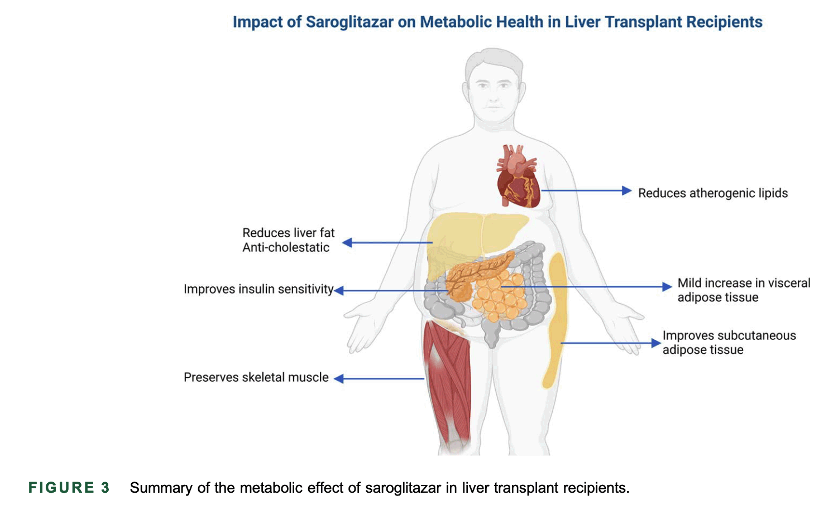| |
Saroglitazar Magnesium 4 mg for NASH in People Living With HIV in the US (SARONAPLUS)
|
| |
| |
Download the PDF here
Download the PDF here
Download the PDF here
https://clinicaltrials.gov/ct2/show/NCT05211284
EDITORIAL - Saroglitazar for the Treatment of NASH: The Peroxisome Proliferator‐Activated Receptor Story Goes On!
2 studies
Saroglitazar improves nonalcoholic fatty liver disease and metabolic health in liver transplant recipients
Jan 2023
Abstract
NAFLD is common after liver transplantation (LT) and is associated with an increased metabolic burden. Currently, there is a paucity of investigations into the treatment of post-LT NAFLD. In the present study, we evaluated the safety and efficacy of saroglitazar, a novel dual peroxisome proliferator–associated receptor α/γ agonist, on the treatment of post-LT NAFLD and metabolic burden. This is a phase 2A, single-center, open-label, single-arm study in which patients with post-LT NAFLD received saroglitazar magnesium 4 mg daily for 24 weeks. NAFLD was defined by a controlled attenuation parameter ≥264 dB/m. The primary endpoint was the reduction in liver fat as measured by MRI proton density fat fraction (MRI-PDFF).
Secondary MRI-based metabolic endpoints included visceral adipose tissue, abdominal subcutaneous adipose tissue volumes, muscle fat infiltration, and fat-free muscle volume.
Saroglitazar treatment led to a reduction in MRI-PDFF from 10.3±10.5% at baseline to 8.1±7.6%.
A relative 30% reduction from baseline MRI-PDFF value was noted in 47% of all patients and 63% of patients with baseline MRI-PDFF >5%.
Reduction in serum alkaline phosphatase was an independent predictor of MRI-PDFF response. Saroglitazar did not decrease fat-free muscle volume nor increase muscle fat infiltration, but did lead to a mild increase in visceral adipose tissue and abdominal subcutaneous adipose tissue. The study drug was well tolerated and a mild nonsignificant increase in serum creatinine was noted. Saroglitazar did not affect the weight. The study provides preliminary data demonstrating the safety and metabolic benefits of saroglitazar in LT recipients and underscores the importance of future studies to establish its efficacy after LT.
-------------------------
Saroglitazar, a PPAR‐α/γ Agonist, for Treatment of NAFLD: A Randomized Controlled Double‐Blind Phase 2 Trial
Abstract
Background and Aims
NAFLD is characterized by insulin resistance and dysregulated lipid and glucose metabolism. Saroglitazar, a dual peroxisome proliferator activated receptor‐α/γ agonist, improves insulin sensitivity, and lipid and glycemic parameters. Saroglitazar improved NASH histology in animal studies. In this randomized controlled clinical trial, we evaluated the efficacy and safety of saroglitazar in patients with NAFLD/NASH.
Approach and Results
A total of 106 patients with NAFLD/NASH with alanine aminotransferase (ALT) ≥ 50 U/L at baseline and body mass index ≥25 kg/m2 were randomized in a 1:1:1:1 ratio to receive placebo or saroglitazar 1 mg, 2 mg, or 4 mg for 16 weeks. The primary efficacy endpoint was percentage change from baseline in ALT levels at week 16. Liver fat content (LFC) was assessed by MRI proton density fat fraction. The least‐squares mean percent change from baseline in ALT at week 16 was -25.5% (5.8), -27.7% (5.9), and -45.8% (5.7), with saroglitazar 1 mg, 2 mg, and 4 mg, respectively, versus 3.4% (5.6) in placebo (P < 0.001 for all). Compared with placebo, saroglitazar 4 mg improved LFC (4.1% [5.9] vs. -19.7% [5.6]), adiponectin (-0.3 μg/mL [0.3] vs. 1.3 μg/mL [0.3]), homeostatic model assessment–insulin resistance (-1.3 [1.8] vs. -6.3 [1.7]), and triglycerides (-5.3 mg/dL [10.7] vs. -68.7 mg/dL [10.3]) (P < 0.05 for all). Saroglitazar 4 mg also improved lipoprotein particle composition and size and reduced lipotoxic lipid species. Saroglitazar was well‐tolerated. A mean weight gain of 1.5 kg was observed with saroglitazar 4 mg versus 0.3 kg with placebo (P = 0.27).
Conclusions
Saroglitazar 4 mg significantly improved ALT, LFC, insulin resistance, and atherogenic dyslipidemia in participants with NAFLD/NASH.

| |
| |
| |
|
|
|